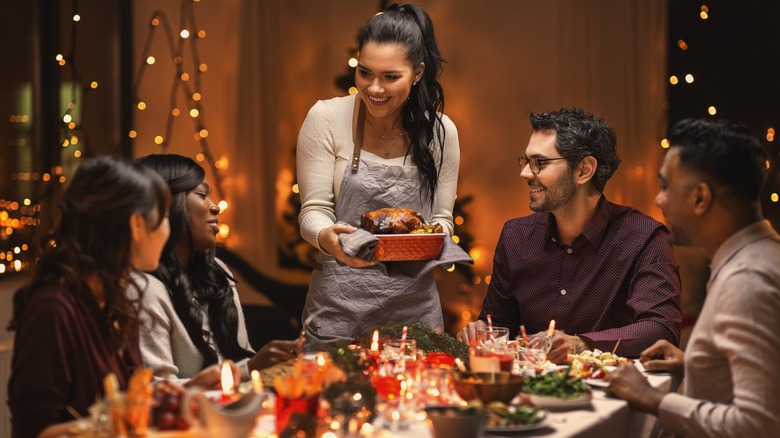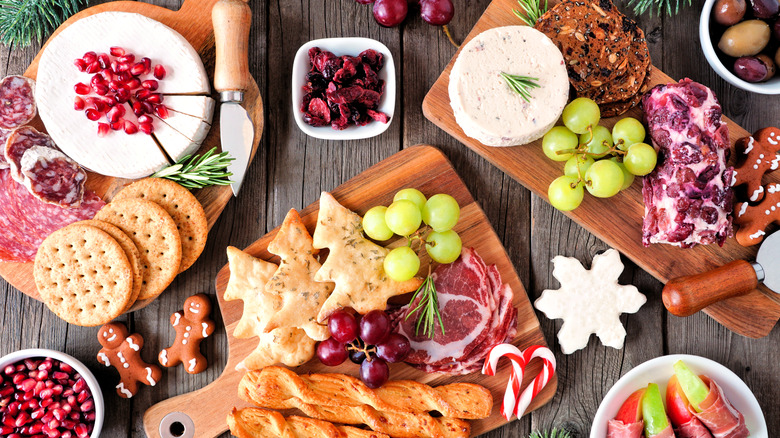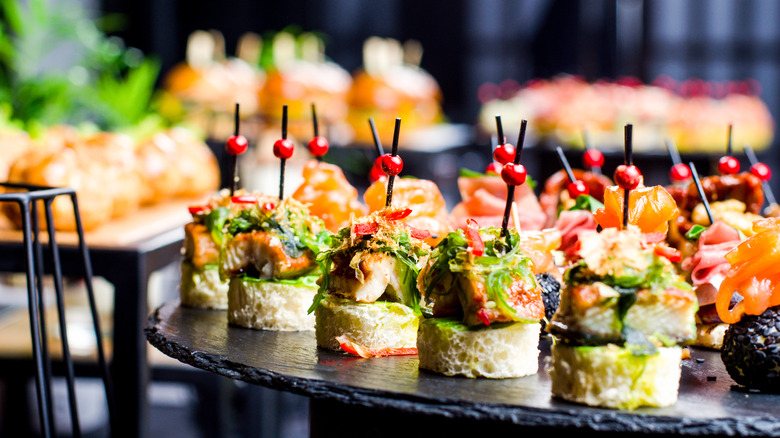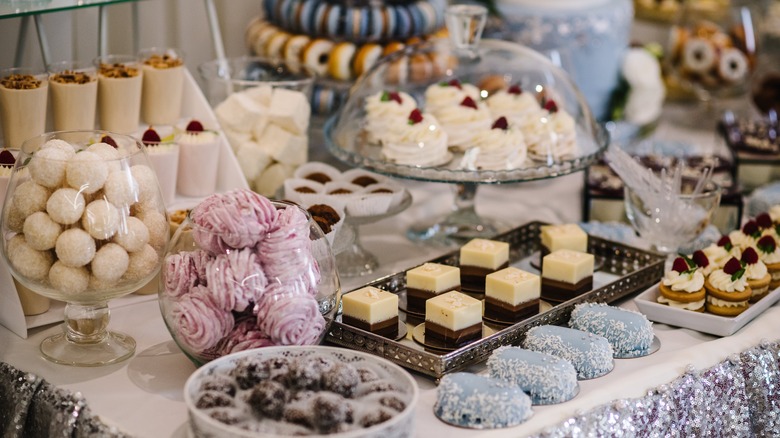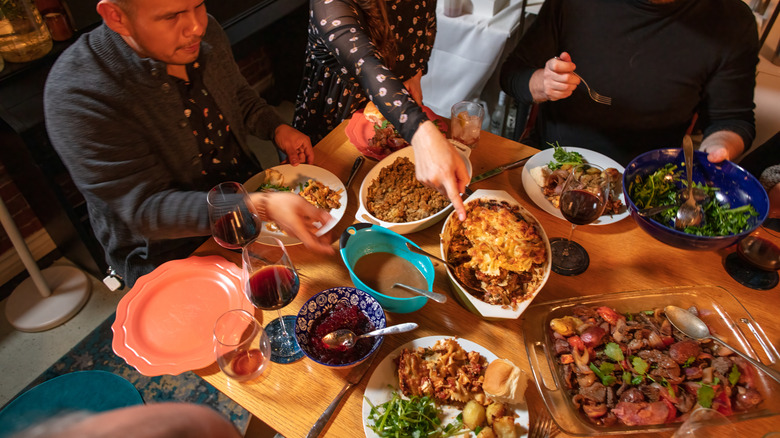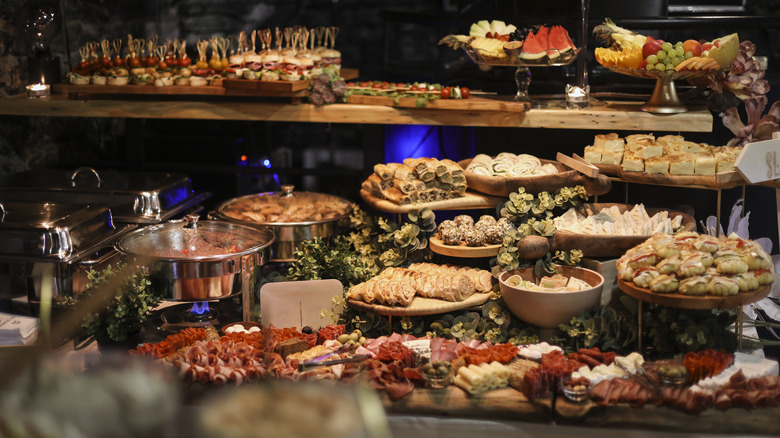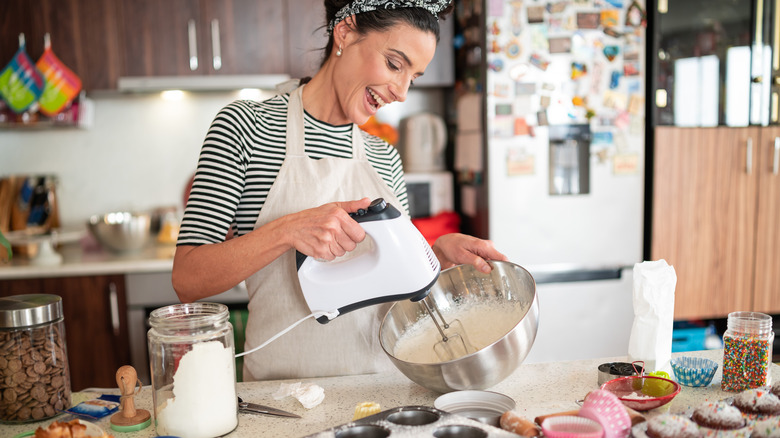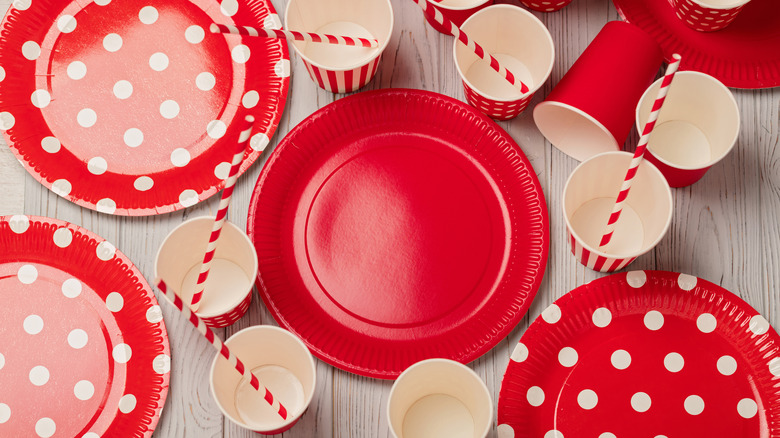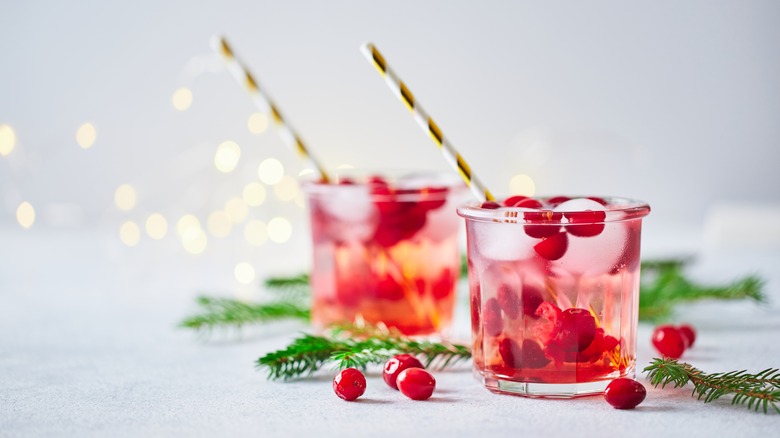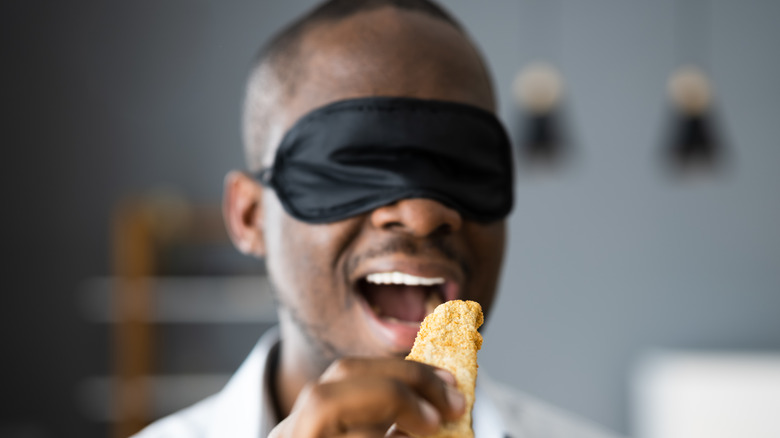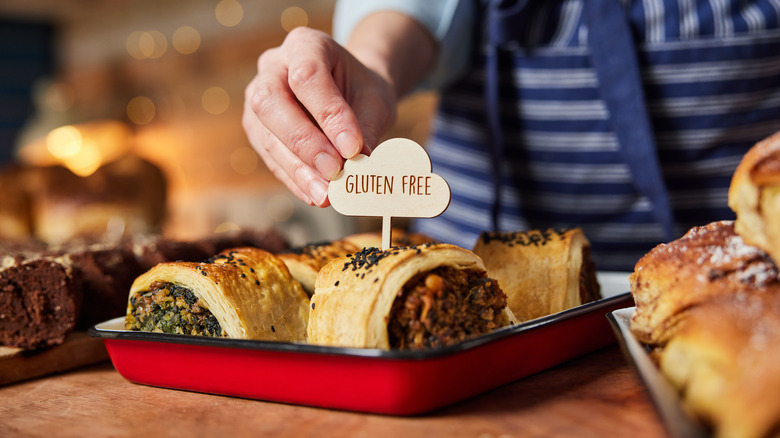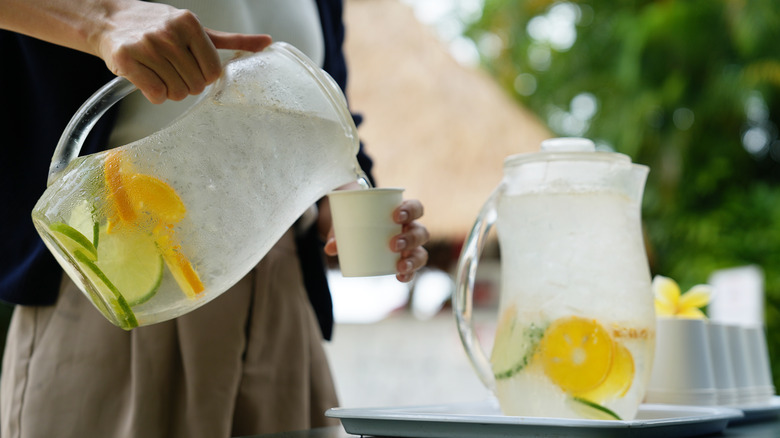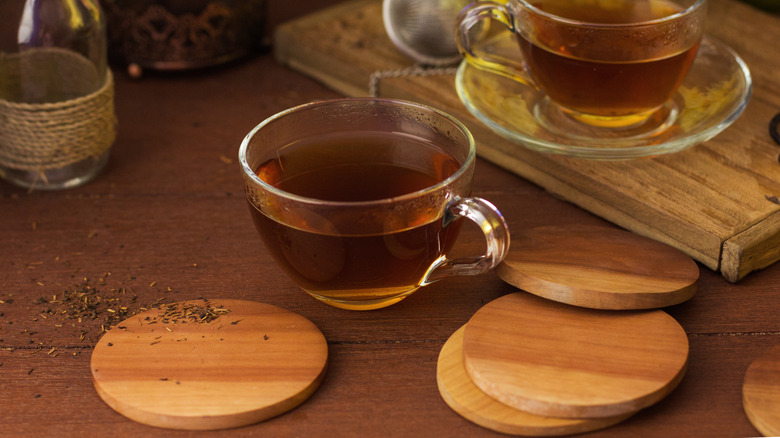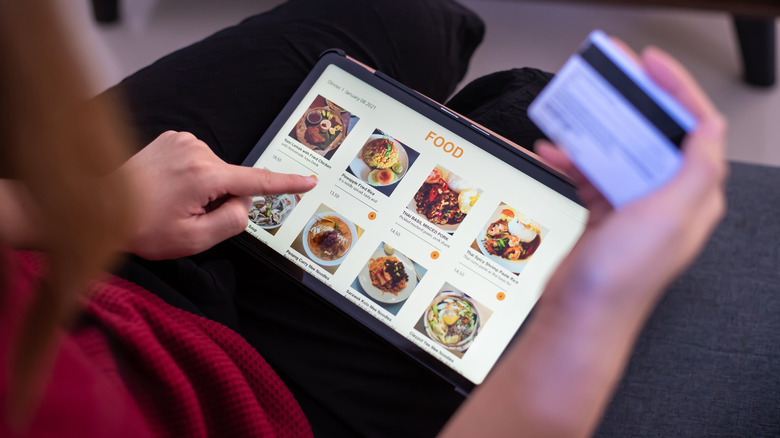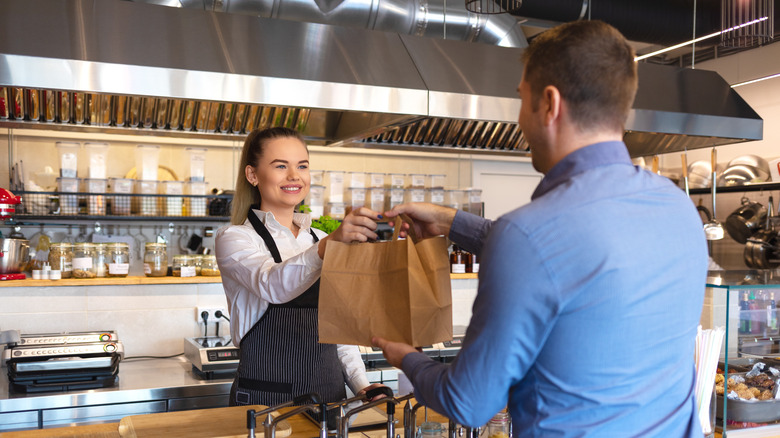21 Food Tips For Hosting The Best New Year's Eve Party
As the year winds to a close, many of us will start reflecting on the best way to celebrate the occasion. Some like to spend it quietly tucked under a blanket on the couch, while others enjoy attending a party. If you are part of the latter group and want to host a dynamite New Year's bash at your home but feel a bit daunted by the idea, you have landed in the right place.
What makes me an expert? I owned and ran a bed and breakfast and restaurant for nearly two decades, where we threw an annual New Year's party. These festivities took on myriad formats, from casual gatherings with plenty of hors d'oeuvres and live music to a six-course sit-down themed dinner with wine pairings. What was always certain was that food and beverages played a central role in our parties.
You could say that we have mastered the art of throwing a New Year's Eve party, and I am here to share some insider information with you to help take the stress out of doing so. If you want to host a New Year's Eve party like a professional, read through these dynamite tips and tricks of the trade. By the end, you will be primed to be the host or hostess with the most, armed with all the skills to create a night of food, drinks, and fun to remember.
Plan ahead
Pre-planning a party is necessary to help alleviate stress and to ensure you are not scrambling to pull things together the night of your event and get to enjoy the party with your guests. This is the time for list-making. Outline everything in detail, from the guests you plan to invite to the menu.
Think through the flow of the evening. You'll want a basic hour-by-hour structure to keep everyone engaged until midnight. Jot down notes about any special food needs, beverage needs, and what serving platters, plates, or glasses you might need so you can purchase anything you may not already have.
Additionally, create a grocery list organized by departments of the store you plan to shop at. Every store is organized slightly differently, and having your list put together by department will expedite your shopping exponentially and eliminate the possibility of accidentally missing something.
Lastly, create a timeline of events for the week before your party. Plan out when you are going shopping, which day to clean, what day to decorate, which dishes to prepare in advance, and what needs to be made on the day of your event.
Go with a theme
Selecting a theme is one of the best ways to plan a party. The possibilities are virtually endless — themes can range from specific regional dishes to food-focused movies to foods and cultural heritages of invitees. Perhaps the most well-received and attended-themed dinner we hosted was focused on foods considered good luck in cultures across the globe.
This kind of themed dinner requires research and creativity to develop a harmonious menu, which can be time-consuming. But it yields a delicious dining experience and provides guests with something fascinating to talk about. Just don't forget to carry the theme throughout the evening. You will want to select decorations, music, and party favors to fit your theme. And, of course, don't forget to choose the appropriate beverages to suit the theme. Every culture has distinct libations to pair with your meal. This attention to detail will make your guests feel special and elevate the experience into something truly extraordinary.
Stick with a buffet or finger foods
The benefit of opting for a buffet or finger foods is that you can enjoy your company once the food is out. A buffet is great for guests because it gives them plenty of choices. They can take or leave what they want and continue grazing throughout the evening. This is particularly useful if you expect guests to be imbibing alcoholic beverages.
When planning an appetizer buffet, the key is diversity. A good rule of thumb is to select 20% hot and 80% cold or room temperature items and incorporate sweet and savory dishes. Try to look at different textures and flavors that are unique yet complementary. Recipes should have an arc even if they don't follow a theme. Dishes should be harmonious together and be enjoyable on their own.
For something slightly more elegant, you might pass around appetizers. In this case, items that can be eaten in one bite and do not require utensils are preferable. This will enable guests to mingle casually without having to sit down to eat, though it does require a bit more effort on your part as the host.
For a smaller crowd, consider a sit-down dinner
Depending on the size of the crowd you expect to entertain and the layout of your home, a sit-down dinner might be a suitable option for the evening. Only you know what that magic number is, but as a general rule, a party of eight is a manageable-sized group for a sit-down dinner. Any more than that can become too much work for you as the host to be able to enjoy the meal and evening without focusing on serving and cleaning up.
You might begin somewhat earlier if you do decide to do a sit-down dinner, particularly if you do not anticipate the crowd staying until midnight. Doing so gives guests the time to enjoy a leisurely meal without feeling rushed.
When serving a sit-down dinner, consider beginning the evening with a toast and perhaps an appetizer to facilitate conversation and ease everyone into the meal. After the meal, offer a digestif and the opportunity to interact away from the dinner table so you can clear any remaining dishes you want to get soaking.
Do an all-dessert party
Should you decide not to make a full sit-down meal or plan to start the party later in the evening after dinnertime, you might consider offering desserts only. People love dessert, and sticking with sweets eliminates the need for complex menu planning or exhaustive cleanup. The key is to make the choices diverse.
Depending on the size of the crowd, four or five different desserts should be adequate. Chocolate is always a good idea, as is something fruity. Pie is a classic choice this time of year, but you could do something simpler, like a crumble or a clafouti. And don't forget the basics. Cookies, brownies, or other grab-and-go items are always welcome.
Serve the desserts buffet style with plenty of whipped cream or ice cream at the ready. You might consider having regular and decaffeinated coffee and tea with the fixings to accompany the sweets and keep the crowd alert until midnight.
Consider a potluck
Throwing a party doesn't have to be an exhausting experience, cost a fortune, or be labor intensive. This is where a potluck makes sense. It takes the onus off of you as the host to plan the entire evening and produce all the food while enabling your guests to feel like they are part of the event.
That said, there are a couple of good rules of thumb to follow to facilitate a successful potluck event. You should ask each guest to bring a specific type of dish or offer the group options to select from a wish list. This eliminates the possibility of everyone making the same kind of dish. You could also establish a theme and encourage guests to develop a dish that fits it. This is always great fun and allows people to flex their creative juices.
As far as the evening itself, make things casual. A potluck isn't the place to be fussy. Set up a simple buffet and allow people to graze throughout the evening. Be sure to have plenty of serving utensils, and find out ahead of time what heating or cooling equipment your guests will require for their dishes.
Have plenty of kid-friendly items on hand
Plan accordingly if you anticipate having children at your New Year's Eve party. Kids often have different dietary needs from grown-ups. This doesn't mean you cannot plan something special for the adults, but you should ensure children have plenty of foods they will like.
Popular dishes include macaroni and cheese, chicken fingers, and french fries or chips. In numerous attempts at producing gourmet iterations of these foods, we found that kids almost always preferred boxed or store-bought iterations. If you aren't sure, ask the parents what they think their kids will eat so that you can be prepared. There is also no reason not to ask a parent to bring a particular food item they know their child will eat.
When children are present, serve them first. This allows the children a distraction so the parents can enjoy their meal. A simple offering of ice cream in chocolate, vanilla, and strawberry flavors with chocolate syrup is always a popular dessert. Lastly, don't forget beverages. Have milk, juice, and various sodas on hand that the kiddos can choose from. Happy kids equal happy parents.
Make sure you have enough food
It can be a challenge to figure out how much food to prepare. You don't want to run out or have a ton of leftovers. Caterers typically aim for 1 pound of food per adult and ½ pound per child, depending on the menu chosen.
If you follow recipes, you will likely have guidance for how many each serves, eliminating the guesswork. For appetizers, 2 to 4 ounces, or five to six bites, per person is about accurate. Six to eight appetizers for a dozen guests is average. Expect people to take one or two servings of each. With this in mind, make a double batch of each appetizer to accommodate anyone wanting seconds or even thirds.
Lastly, beverages matter, particularly for a party that will last longer than a typical gathering. One drink per hour per person on average is a safe bet. A bottle of wine has five servings, while a 12-ounce beer is considered a single serving. An 8-ounce glass is a good serving size for non-alcoholic beverages. And if you know your crowd are enthusiastic partiers, aim high and have extra drinks on hand.
Figure out what dishes can be made in advance
Think about what recipes can and should be prepared ahead. Some dishes taste better after marinating, while others are forgiving and can be reheated easily or baked at the last minute. Still others can be made in the crock pot where you can set it and forget it, eliminating the need for active preparation.
Even if a dish cannot be made ahead, review a recipe to see what components can be premade. This may include chopping vegetables, making sauces or dressings, or marinating meats. Lastly, determine whether your menu is evenly distributed between dishes that can be made stovetop versus those that require the oven to be baked. If you have more oven-baked items than your kitchen can handle, consider substituting a recipe for something that can be prepared using a different cooking method.
The goal is to enable you to enjoy your party. There is no sense in planning a menu that requires you to spend all day in the kitchen before the party begins. You will be tuckered out way before midnight, leaving you unable to appreciate the fun of celebrating the new year with your guests.
Keep hot foods hot and cold foods cold
Keeping food at a safe serving temperature throughout the evening is crucial if you go the buffet route. The USDA calls anything between 40 and 140 degrees Fahrenheit within the "Danger Zone." For this reason, hot foods must be kept hot, and cold foods must be kept below 40 degrees. The best way to do this is with ice baths and chafing dishes.
With cold foods, placing the serving platter atop a second bowl filled with ice and replenishing this with fresh ice should suffice. Small chafing dishes that use a Sterno can easily be obtained for hot dishes. If this is inconvenient, use crock pots set to warm to maintain a safe temperature.
The CDC suggests that perishable foods kept within the Danger Zone for two hours should be discarded. If you are in an environment where temperatures exceed 90 degrees Fahrenheit, discard perishable foods after one hour. For a lengthy event, like a New Year's Eve party, you may want to prepare two serving platters and swap these out halfway through the evening to have fresh food at all times.
Disposable is fine, but make it elegant
Perhaps the biggest hassle and least enjoyable part of hosting a New Year's Eve party is cleaning up. While you cannot eliminate dishes or cleanup altogether, you can minimize the workload using disposable plates, napkins, cups, and flatware.
Disposables may not be as elegant as fine china, but they can still be classy. Plenty of festive-looking offerings exist to help make your evening a special occasion. You can even purchase themed items with "Happy New Year" on them. The key is to obtain disposable ware that is sturdy enough to withstand heavier foods. You don't want flimsy plates that will crumble under a few meatballs.
Another consideration to help make things more user-friendly for your guests is to invest in appetizer plates with wine glass holders. These come in myriad iterations, from fancy bamboo or wood contraptions to inexpensive disposable heavy-duty plastic varieties. These are brilliant for a buffet. They enable guests to eat and mingle simultaneously without having to sit down or risk spilling something.
Whip up some mocktails
Whether you have children in attendance or individuals opting not to imbibe for whatever reason, having some fancy mocktails available is always a great idea. There is no reason you cannot make a non-alcoholic beverage fun, festive, and delicious. With just a few exciting ingredients and a little ingenuity, you can create a drink that will satisfy all your guests.
Some of our favorites include mock Moscow mules, virgin margaritas, and mojitos with lots of fresh mint and fruits of all kinds. The key to jazzing up a mocktail is to use plenty of color, aromatics, and fun garnishes. You should also consider layering complex flavors, including sweet, sour, bitter, and acid components. This helps to increase the interest and nuance of a mocktail.
Lastly, don't forget about texture, particularly with blended drinks. You want to guarantee beverages are perfectly slushy to make them feel more satiating. Consider investing in a high-quality blender you can use on other occasions for making soups or sauces, like a Ninja or a Vitamix.
Have plenty of festive libations on hand
Having plenty of alcoholic beverages on hand for a party is crucial. A good rule of thumb is one drink per person an hour plus a little extra. You want to encourage a good time while also drinking responsibly. For reference, one bottle of wine contains five drinks, while a 12-ounce beer is considered one serving. If you offer other alcoholic beverages or mixed drinks, refer to the serving sizes indicated on the recipe or bottle to determine how much you will need.
While bubbly is the ultimate party choice, you can also whip up a sangria or other festive punch. Select a few red and white wines to accommodate those with differing tastes. The key is to know your audience. If the guests you have invited prefer drinking beer over wine, give them beer. If you aren't sure, ask ahead. A party should be fun, not an exercise stretching your guest's culinary or libationary horizons.
Finally, if you decide to establish a theme for the party, do not miss out on the opportunity to theme your alcoholic beverages. Virtually every culture has its distinct alcohol you can serve.
Come up with some clever food- and beverage-themed games to pass the evening
Food lovers will want to extend their enthusiasm beyond what they consume and imbibe and into the activities planned for the evening. Playing food and beverage-themed games throughout the party can be great fun and help keep the crowd alert until midnight. The key is to tailor the games to your audience.
While you can purchase various food-themed trivia and card games, try conducting a simple Google search. You will find any number of fun foodie activities. Some favorites include food bingo, a treasure hunt, and competitive eating games.
One that may require more effort for you as the host but will have your guests in stitches is a guess-the-dish-themed game. You will need blindfolds for all competitors and enough samples of each item to accommodate them. Then, ask the players to guess what they are eating. But be kind. You don't want to surprise your guests with overly spicy foods or those that may be too much of an acquired taste.
Poll your guests about any special dietary needs
When you send out invites, you will want to ask guests to RSVP with any dietary restrictions they may have. You want your guests to feel comfortable and have plenty to eat without needing to bring their food or ask too many questions, whether these restrictions are allergies or preferences. Once you know what dietary needs you will be dealing with, you can tailor the menu to accommodate all these or include dishes specifically for those individuals.
When serving your meal or setting up your buffet, clearly mark items prepared to accommodate dietary restrictions for those in attendance so they do not have to guess what they can eat. This will also prevent accidental ingestion of something that might make somebody ill. Should the list of dietary needs be limited, you might consider making all items without said allergen or ingredient to eliminate any unnecessary conversation around the topic. Those who have allergies will not want to spend their evening explaining to others why they cannot eat a specific food.
Set your buffet up in a logical order
How you lay out your buffet will make or break the evening. While there is no one right way to do this, there are some helpful tips to make the evening flow better and keep the buffet from turning into a traffic jam that impedes everyone's ability to mingle and enjoy the food and the company of others. The key is to figure out what makes sense in your space.
Though some suggest multiple stations, this may or may not be feasible in your home. We often split the buffet into three stations: beverages, savory items, and desserts. For each, indicate a clear beginning by providing your plates, napkins, flatware, and glassware, depending on the station. Ensure every item has its own designated serving utensils and is clearly labeled.
Creating levels will make food easily visible and convenient to serve. This can be accomplished using tiered trays or cake stands. You will want to group similar foods in an order that makes sense for your menu. When decorating the table, make it simple, classy, and easy to wipe down. Lastly, don't forget to provide designated trash cans and recycling bins for guests.
Have a water station to keep guests hydrated
Hydration stations may seem obvious but are sometimes an afterthought, particularly when you are focused on having adequate alcoholic and non-alcoholic beverages to satisfy all your guests' needs. Water should be available throughout the evening in a location that is readily accessible to keep people sufficiently hydrated. You can opt for bottled water or a pitcher of filtered water. New Year's Eve can be more of a marathon than other parties because of the late end time, so keep an eye on the water station throughout the evening.
You might consider supplying both sparkling and still water to accommodate differing tastes. You can also doctor the water with lemon, mint, or cucumber slices and put it in a decorative punch bowl for something more elegant. If you want to go all out, provide mix-ins. There are myriad flavored powders that you can purchase to encourage your guests to drink plenty of water throughout the evening. Lastly, have a fresh bowl of ice cubes on rotation for those who prefer to drink cold water.
Provide plenty of places for guests to set their beverages and plates
There is a fine line between having enough decorations to make things festive and cluttering up the space so much that guests don't have anywhere convenient to set down plates or glasses. A good rule of thumb is that horizontal spaces are for guests, while vertical spaces are for you. This is not an exact science, but it does help to temper the impulse to fill every space with party favors, candles, or streamers.
If you are concerned about damage to wood furniture, cover anything delicate with a runner or tablecloth and scatter coasters generously throughout your home. This will encourage guests to use them and hopefully reduce the potential for spills or condensation that leaves water marks behind.
Lastly, you should provide plenty of space for guests to sit down. Even if you are serving a buffet with finger foods, guests will eventually want to sit down for a while, especially if you are going to play games or enjoy lengthy conversation late into the evening. Simple folding chairs can be fine if you do not have enough seating.
Order groceries online
December is a busy time of year. Going to the grocery store can be overwhelming between the holidays, shopping for gifts, vacations, and travel. Factor in the issue of fighting crowds and not finding the items you need for a specific recipe, which can completely derail your entire plan, and this is where ordering groceries online can be a lifesaver.
If there are specific dishes you plan to make that use exotic spices, unusual cuts of meat, or specialty ingredients, like a type of cheese or chocolate that may not be readily available, consider placing an order to have these shipped to your home. Several online gourmet food stores offer free expedited shipping for virtually any ingredient you may need.
For your regular grocery shopping, order online for pick up. While there are downsides to this, including not being able to select the kind of produce you may want or getting damaged items, for the most part, this process can save a lot of time and hassle. Most stores have a minimum amount to order, but beyond that, there are no additional costs. This is particularly helpful when visiting multiple stores to get everything needed.
Order in
If you want to host a party but do not want to make the food you serve, there is no shame in ordering in. New Year's Eve does not need to be overly fancy to be great fun, and there are plenty of options to order to-go, pick-up, or frozen items you can reheat, eliminating additional fuss or work.
When opting to order in or pick up, you should pre-plan. Restaurants serving on New Year's Eve are often busy that evening. Plenty of advance notice to prepare your meal will guarantee your order is accurate and fresh. If you are ordering pre-made items online that you can reheat, plan to have them delivered well in advance so you do not have to worry about the food at the last minute.
Even if you do not want to be fancy, transferring pre-made foods to serving platters is a nice gesture. Doing so will make the evening more special without that much extra effort. And do not forget to factor in any thawing time for dishes that require reheating. That can make or break your evening.
Accept help where you need it
Hosting a New Year's Eve party can be a lot of work. If you are unaccustomed to doing so or feel overwhelmed, do not hesitate to accept help where you need it. This is the time to put your delegation skills to work. Assign others duties that can liberate you from the tasks you don't necessarily enjoy doing or do not have time for, like decorating or cleaning, so you can focus on the food and beverages.
This also applies to food and beverages. You can purchase something from a bakery, buy a box mix, or ask someone else to bring the desserts if you enjoy making savory items, but baking is not your forte. Similarly, enlist an oenophile guest to pair and purchase appropriate wines to accompany your meal if you are unsure what vino to provide. Ultimately, hosting a New Year's Eve party should be fun, even if it does require some work. Do what you need to in order to make the entire process from beginning to end as carefree and enjoyable as possible, including asking for help.
